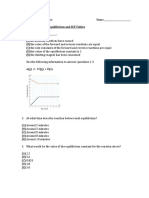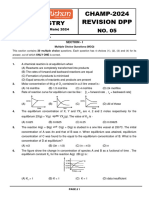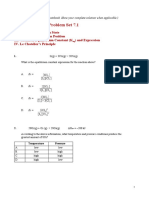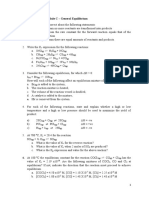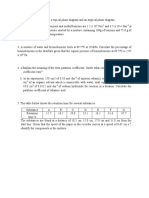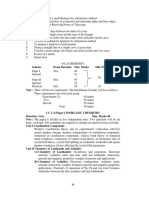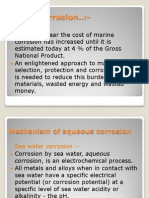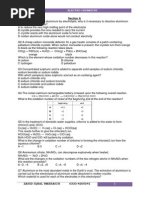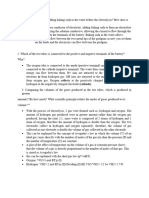APEF Jan02
APEF Jan02
Uploaded by
pei ClaudiaCopyright:
Available Formats
APEF Jan02
APEF Jan02
Uploaded by
pei ClaudiaOriginal Description:
Original Title
Copyright
Available Formats
Share this document
Did you find this document useful?
Is this content inappropriate?
Copyright:
Available Formats
APEF Jan02
APEF Jan02
Uploaded by
pei ClaudiaCopyright:
Available Formats
Chemistry 12 - APEF Examination
January 2002
Multiple Choice
___A_ 1.
Which statements are true?
i) A thermochemical equation must include the physical states of all substances.
ii) The coefficients in a themochemical equation are interpreted as moles.
iii) The sign of ∆H for an endothermic reaction is negative.
A. i) and ii) B. i) and iii) C. ii) and iii) D. i), ii), and iii)
__D__ 2. Which one of the following processes is endothermic?
A. C(s) + O2(g) ¼ CO2(g) C. H2O(g) ¼ H2O(s)
B. 2H2(g) + O2(g) ¼ 2H2O(g) D. H2O(s) ¼ H2O(l)
__B_ 3. What is the ∆Hºf of hydrogen fluoride?
H2(g) + F2(g) ¼ 2HF(g) + 542 kJ
A. –542 kJ B. –271 kJ C. +271 kJ D. +542 kJ
__D__ 4. What is the specific heat capacity of a substance if 167 J are needed to change the temperature of 15.
0 g of it from 25.0ºC to 33.0ºC?
A. 0.19 J/g•ºC B. 0.34 J/g•ºC C. 0.72 J/g•ºC D. 1.4 J/g•ºC
__D__ 5. Which process involves the largest enthalpy change?
A. combustion of CH4(g) C. formation of HCl(g)
B. condensation of H2(g) D. fusion of H(g)
___A_ 6. Which represents an exothermic process?
A. 2CO(g) + O2(g) ¼ 2CO2(g) ∆H = –566 kJ
B. 2H2O(l) ¼ H2O2(l) + H2(g) ∆H = 384 kJ
C. N2(g) + O2(g) + 180 kJ ¼ 2NO(g)
D. This diagram:
__A__ 7. If the heat of formation for the chemical reaction S8(s) + 12O2(g) ¼ 8SO3(g), is –395.7 kJ/mol of SO3, how can
the equation be rewritten to include the heat term?
A. S8(s) + 12O2(g) ¼ 8SO3(g) + 3166 kJ C. S8(s) + 12O2(g) ¼ 8SO3(g) + 395.7 kJ
B. S8(s) + 12O2(g) ¼ 8SO3(g) – 395.7 kJ D. S8(s) + 12O2(g) + 3166 kJ ¼ 8SO3(g)
__B__ 8Use the equations to answer the question below.
2A + B ¼ A2B ∆H = –377.7 kJ
2A + BC ¼ A2B + C ∆H = –475.6 kJ
What is the value of ∆H for the reaction B + C ¼ BC?
A. +853.3 kJ B. +97.9 kJ C. –97.9 kJ D. –853.3 kJ
___B_ 9. When a mixture of solid KNO3 and water is prepared, what is the KNO3 called?
A. precipitate B. solute C. solution D. solvent
___C_ 10. What is the concentration of a solution if 34 g of NH3 is dissolved in enough water to make 500 mL of solution
? A. 4.0 x 10–4 mol/L B. 6.8 x 10–3 mol/L C. 0.40 mol/L D. 6.8 mol/L
__B__ 11. What is the concentration of a solution of sulphuric acid that is prepared by the dilution of 150 mL of 5.00 mol
H2SO4 to 2.00 L?
/L
A. 0.150 mol/L B. 0.375 mol/L C. 0.500 mol/L D. 0.750 mol/L
___D_ 12. Combining which solutions would result in a precipitate(See the Solubility Table on page 12 in the Chemistry Data
Booklet.)
A. Ca(NO3)2(aq) and NaClO3(aq) C. Pb(NO3)2(aq) and NaClO3(aq)
B. Ca(NO3)2(aq) and NaI(aq) D. Pb(NO3)2(aq) and NaI(aq)
___C_ 13. What is the definition of molarity of a solution?
A. moles of solute per kilogram of solution C. moles of solute per litre of solution
B. moles of solute per kilogram of solvent D. moles of solute per litre of solvent
__C__ 14. Which combinations of solid and liquid would likely form a solution?
I. ionic solid and nonpolar liquid III. nonpolar solid and nonpolar liquid
II. ionic solid and polar liquid IV. nonpolar solid and polar liquid
A. I and III B. I and IV C. II and III D. II and IV
___D_ 15. What effect does a catalyst have?
A. increases the reaction rate by decreasing the heat of reaction
B. increases the reaction rate by increasing the activation energy of the reverse reaction
C. increases the reaction rate by lowering the activation energy of the forward reaction only
D. increases the reaction rate by providing an alternative pathway with a lower activation energy.
___D_ 16. The rate of a chemical reaction may depend upon which factors?
I. concentration of reactants II. nature of reactants III. temperature
A. I and II B. I and III C. II and III D. I, II, and III
Chemistry 12 – APEF Examination – January 2002 – page 1 of 4
__C__ 17. Which change increases the rate of formation of CO2 in this reaction?
BaCO3(s) + 2H+(aq) ¼ Ba2+(aq) + H2O(l) + CO2(g) + heat
A. adding water to the system C. finely powdering the BaCO3(s)
B. decreasing the temperature of the system D. increasing the concentration of Ba2+(aq)
___C_ 18Which statement concerning an equilibrium is true?
A. It cannot exist between a liquid and its vapour.
B. It does not exist when the temperature is constant.
C. It exists in a closed system.
D. It occurs in all chemical reactions.
__B__ 19. Which would definitely increase the concentration of NO2(g present at equilibrium in this reaction
? 2NO(g) + O2(g) ' 2NO2(g) + 113 kJ
A. adding a catalyst C. increasing the volume
B. adding NO(g) D. increasing the temperature
__C__ 20. The potential energy diagram for the reaction, Br + H2 ' HBr + H, is:
What is the heat of reaction for the forward reaction?
A. –117 kJ/mol B. –105 kJ/mol C. +105 kJ/mol D. +117 kJ/mol
__C__ 21. Which of these equilibria will shift to the left as a result of a decrease in volume?
A. H2(g) + Cl2(g) ' 2HCl(g) C. 2SO3(g) ' 2SO2(g) + O2(g)
B. N2(g) + 3H2(g) ' 2NH
O3(g)
3 + ) s ( e F 4. D 2(g) ' 2Fe2O3(s)
__A__ 22Which will cause an increase in the numerical value of the equilibrium constant for this reaction?
C(s) + 2H2(g) ' CH4(g) + 75 kJ
A. decreasing the temperature C. finely powdering the C(s)
B. decreasing the volume D. increasing [H2]
__C__ 23At equilibrium in this gaseous system
2A + B ' 2C + D
[A] = 2.00, [B] = 1.20, [C] = 3.00, and [D] = 0.600. What is the numerical value of the equilibrium constant?
A. 4.32 B. 1.33 C. 1.12 D. 0.889
__A__ 24. Which statement is true for this reaction if its equilibrium constant equals 1.6 x 106?
2CO(g) + O2(g) ' 2CO2(g)
A. It goes essentially to completion at equilibrium.
B. It goes only in one direction.
C. It does not take place to a significant extent.
D. It takes place very rapidly.
__D__ 25. Which statement is true for a solubility equilibrium?
A. Neither dissolving nor crystallizing is occurring.
B. The concentration of solute always equals the concentration of solvent.
C. The mass of dissolved solute is always less than the mass of solvent.
D. The rate of dissolving equals the rate of crystallizing.
___A_ 26. What is the equilibrium constant expression for the reaction,
CaCO3(s) ' CaO(s) + CO2(g)
[CaO] [CaCO3 ] [CaO ][CO2 ]
A. K = [CO2 ] B. K= C. K= D. K=
[CaCO3 ] [CaO ][CO2 ] [CaCO3 ]
__B__ 27. The equilibrium
CO(g) + H2O(g) ' CO2(g) + H2(g) K = 0.50
Is established in a one litre container. If 2.0 mol of CO and 3.0 mol of H2O are in equilibrium with 4.0 mol of H2,
how much CO2 is present?
A. 0.33 mol B. 0.75 mol C. 2.0 mol D. 3.0 mol
__A__ 28. Which statements are true for an aqueous solution of an acid?
I. conducts electricity II. reacts with zinc forming hydrogen gas III. turns red litmus blue
A. I and II B. I and III C. II and III D. I, II, and III
__D__ 29. According to the Arrhenius theory, what does a base do?
A. accepts H+ ions from an acid
B. ionizes completely when dissolved in water
C. ionizes in aqueous solutions to produce hydronium ions
D. produces OH– ions when dissolved in water.
__C__ 30. What is true for an amphoteric (amphiprotic) substance?
A. behaves as a weak acid in solution C. behaves as a weak acid or a weak base in solution
B. behaves as a weak base in solution D. has a very low pH in solution
__D__ 31. What is a Brønsted-Lowry acid?
A. an electron acceptor C. a proton acceptor
B. an electron donor D. a proton donor
Chemistry 12 – APEF Examination – January 2002 – page 2 of 4
__A__ 32. What is one of the acid-base conjugate pairs in this equilibrium?
CN–(aq) + H2O(l) ' HCN(aq) + OH–(aq)
–
A. HCN, CN B. HCN, H2O C. HCN, OH– D. H2O, CN–
__C__ 33. A 0.1 mol/L solution of an electrolyte has a pH of 6. How may the electrolyte be described?
A. a strong acid B. a strong base C. a weak acid D. a weak base
___B_ 34. A sample of ammonia (approximately 0.1 mol/L, Kb = 1.8 x 10–5) is titrated with 0.1 mol/L HCl. Which indicator
changes colour closest to the equivalence point?
A. alizarin yellow R B. methyl red C. methyl violet D. phenolphthalein
__D__ 35. Which information indicates the most acidic solution?
[H3O+] = 10–3 B. [OH–] = 10–10 C. pH = 6 D. pOH = 12
___B_ 36. What is the effect of adding CH3OO–(aq ions to a solution of acetic acid in water
? CH3COOH(aq) + H2O(l) ' CH3COO-(aq) + H3O+(aq)
A. causes Ka of acetic acid to decrease
B. increases the concentration of CH3COOH molecules
C. increases the degree of ionization of acetic acid
D. reduces the pH of the solution
__A__ 37. If the pH of an aqueous solution is 11, what is the hydroxide ion concentration?
A. 1 x 10–3 mol/L B. 1 x 10–7 mol/L C. 1 x 10–11 mol/L D. 1 x 10–14 mol/L
___A_ 38. When NaOH(aq) is titrated with HCl(aq), what is the pH at the equivalence point?
A. equal to 7 B. greater than 7 C. less than 7 D. undefined
__A__ 39. What is the [H3O+] of seawater that has a pH of 8.10?
A. 7.9 x 10-9 mol/L B. 1.0 x 10–8 mol/L C. 1.3 x 10–6 mol/L D. 8.0 x 10–1 mol/L
__D__ 40. Which is a strong acid as shown by Ka values?
A. H3BO3 B. H2CO3 C. HNO2 D. HNO3
__B__ 41. In the oxidation-reduction reaction
3S2– + 2MnO4– + 4H2O ¼ 3S + 2MnO2 + 8OH–
2–
the S changes oxidation number to give the element S. Which statement is true?
A. S2– gains electrons C. S2– has been reduced
B. S2– has been oxidized D. S2– is an oxidizing agent
__B__ 42. Which species has the highest oxidation number for manganese?
A. MnO2 B. MnO4– C. Mn2O3 D. MnSO4
__A__ 43. What does the oxidizing agent do in an oxidation-reduction reaction?
A. gains electrons from the reducing agent C. is always oxidized
B. loses electrons to the reducing agent D. is oxidized by the reducing agent
__C__ 44. Which of the following species is the strongest oxidizing agent?
A. Br2 B. Cl2 C. F2 D. I2
___B_ 45. Which of these chemical reactions is an oxidation-reduction reaction?
A. Ba(NO3)2 + Na2SO4 ' BaSO4 + 2NaNO3 C. CO2 + H2O ¼ H2CO3
B. Cl2 + 2NaBr ¼ Br2 + 2NaCl D. HCl + NaOH ¼ NaCl + H2O
__C__ 46Which statement is true for an electrolytic cell?
A. Cations are attracted to the positive electrode.
B. Reduction occurs at the anode.
C. The cell operates on the energy of a power supply.
D. The charge is carried through the external circuit by ions.
__A__ 47. Which process could occur at the cathode of an electrochemical cell?
A. Ag+(aq) + e– ¼ Ag(s) C. half-reaction in which MnO2(s) changes to MnO4–(aq)
2+ –
B. Cu(s) ¼ Cu (aq) + 2e D. oxidation half reaction
__C__ 48. What is the Eº for an electrochemical cell with the reaction: 2Cr + 3Sn 4+ ¼ 3Sn2+ + 2Cr3+
Cr3+ + 3e– ¼ Cr Eº = –0.74 V Sn4+ + 2e– ¼ Sn2+ Eº = 0.15 V
A. 0.45 V B. 0.59 V C. 0.89 V D. 1.93 V
Short Answer and Extended Response Questions:
49. a) Write a balanced chemical equation for the combustion of octane, including the heat of combustion. The combustion
products are CO2(g) and H2O(l). (Value: 3)
b) Sketch an enthalpy diagram for the combustion of octane. Your sketch should indicate the ∆Hcomb value.
(Value: 1)
50. a) Calculate the concentration of glucose (C6H12O6) in a solution in which 10.0 g of glucose is dissolved in water and diluted
to a final volume of 200.0 mL. (Value: 2)
b) Determine the volume of commercial grade nitric acid (15.8 mol/L HNO3) that is needed to prepare 100.0 mL of 3.00
mol/L HNO3. (Value: 2)
51. Initially 0.84 mol of PCl5(g), 0.08 mol of PCl3(g), and 0.05 mol of Cl2(g) are placed in a 1.0 L flask. At equilibrium, 0.78 mol of
PCl5(g) is present. What is the value of the equilibrium constant, K? (Value: 4)
PCl5(g) ' PCl3(g) + Cl2(g)
52. a) What is the pH of a 0.155 mol/L HCl solution? (Value: 1)
b) Calculate the volume of 0.120 mol/L NaOH needed to neutralize 25.0 mL of 0.155 mol/L HCl. (Value: 2)
c) Explain why the end point of an acid-base titration does not always coincide with the equivalence point. (Value: 1)
53. Use half-reactions found on page 11 of the Chemistry Data Booklet to write balanced oxidation-reduction equations for
these reactions:
a) the reduction of acidic MnO4–(aq) solution to Mn2+(aq) by Ni(s) (Value: 2)
b) the oxidation of NO(g) by an acidic Cr2O72–(aq) solution (Value: 2)
Chemistry 12 – APEF Examination – January 2002 – page 3 of 4
54. A solution is prepared by mixing 100 g of water at 50.0ºC with 100 g of ethanol at 10.0ºC.
specific heat capacity of water = 4.18 J/(g•ºC) specific heat capacity of ethanol = 2.42 J/(g•ºC)
a) Complete this table. (Value: 4)
Final temperature Energy lost Energy gained
of mixture (ºC) by water (kJ) by ethanol (kJ)
10.0
20.0
30.0
40.0
50.0
b) Use the two curves described below, plotted on the same
graph, to determine the actual final temperature of the
mixture. (Value: 3)
i) energy lost by water (y axis) against final temperature
ii) energy gained by ethanol (y axis) against final temperature
c) What assumption must be made in order to determine the final temperature of the mixture? (Value: 1)
55. In order for any equilibrium constant (K) value to be useful, a chemical equation for the equilibrium must accompany the K
value.
For example, a group of students was told only that the equilibrium concentrations for all of the substances involved in a
gaseous equilibrium were: [H2] = 1.11 x 10–2 mol/L, [I2] = 1.52 x 10–2 mol/L, and [HI] = 0.100 mol/L.
Three different students wrote three balanced chemical equations for this equilibrium system, and as a result, they
calculated equilibrium constants equal to 0.0169, 7.70, and 59.3.
a) One of the students used the equation: H2(g) + I2(g) ' 2HI(g). Which equilibrium constant value did this student
calculate? (Value: 2)
b) Use the equilbrium constant value from part (a) and the equilibrium conditions, [HI] = 0.200 mol/L and [H2] = [I2], to
calculate the concentration of I2. (Value: 2)
c) Determine and show, which chemical equations correspond to the two other equilibrium constant values.(Value: 4)
56. Use this diagram for a titanium-nickel electrochemical cell to answer parts (a) to (d).
a) Write the equation for the half-reaction that occurs at the anode when
the switch is closed. (Value: 1)
b) What happens to the mass of the titanium electrode when the switch is
closed? (Value: 1)
c) In which direction do cations move through the walls of the porous cup
(i.e., into the cup or out of the cup)? Explain your answer. (Value: 1)
d) Calculate the reduction potential of Ti2+. (Value: 1)
e) A promising power source is the aluminum-air battery. As the cell runs,
aluminum and water are consumed, and the complex ion, Al(OH)4–(aq) is
produced. The half-reaction at the aluminum electrode is: Al(s) + 4OH–
(aq) ¼ Al(OH)4–(aq) + 3e–. In the half-reaction at the porous electrode,
O2(g) and H2O(l) form OH–(aq) ions.
i) Show the direction the electrons flow through the wire in the
diagram of the aluminum-air battery. (Value: 1)
ii) Identify the cathode in the diagram of the aluminum-air battery.
(Value: 1)
iii) Write the half-reaction that occurs at the porous electrode.
(Value: 1)
iv) Write the net electrochemical equation that occurs in the aluminum-
air battery. (Value: 1)
Chemistry 12 – APEF Examination – January 2002 – page 4 of 4
You might also like
- CK-12 Chemistry Intermediate Quizzes & Tests (With Answers) PDFDocument408 pagesCK-12 Chemistry Intermediate Quizzes & Tests (With Answers) PDFJamir Escalante50% (8)
- Quiz 13Document5 pagesQuiz 13Hằng Thanh50% (2)
- MULTIPLE CHOICE. Choose The One Alternative That Best Completes The Statement or Answers The QuestionDocument11 pagesMULTIPLE CHOICE. Choose The One Alternative That Best Completes The Statement or Answers The QuestionOw ZeeNo ratings yet
- Practice 14Document9 pagesPractice 14ALEJA MNo ratings yet
- 4th Periodical Test Chemistry 1 2017 2018 (Mid Term)Document15 pages4th Periodical Test Chemistry 1 2017 2018 (Mid Term)Marjorie BrondoNo ratings yet
- LE2 ProbsetDocument5 pagesLE2 ProbsetChris Andrew MendozaNo ratings yet
- Apef Jan01 AnsDocument13 pagesApef Jan01 Anspei ClaudiaNo ratings yet
- Equilibrium Practice TestDocument11 pagesEquilibrium Practice TestAbeer MajdiNo ratings yet
- Lab Act 4Document4 pagesLab Act 4Churrizo Islami100% (1)
- CHEM2 Long Quiz 2Document4 pagesCHEM2 Long Quiz 2Maria Leonora PaltaoNo ratings yet
- Equilibrium SL QuestionsDocument22 pagesEquilibrium SL QuestionsKarlina MikekNo ratings yet
- Topic 5 15 MC PracticeDocument21 pagesTopic 5 15 MC PracticeDharmesh Ramnarayan YadavNo ratings yet
- 2022 EquilDocument10 pages2022 EquilMary GinetaNo ratings yet
- HL Topic 7 17 EquilibriumDocument9 pagesHL Topic 7 17 EquilibriumDavid Dancer100% (1)
- Gen Chem QuizDocument18 pagesGen Chem QuizNoime Labayog AgravanteNo ratings yet
- Chapter 14 SolutionsDocument25 pagesChapter 14 Solutionsjmb1421No ratings yet
- IB Chemistry - SL Topic 7 Questions 1Document19 pagesIB Chemistry - SL Topic 7 Questions 1vaxor16689No ratings yet
- Which Statement Is True About Chemical Reactions at Equilibrium?Document9 pagesWhich Statement Is True About Chemical Reactions at Equilibrium?Abdusalam IdirisNo ratings yet
- IB2 Revision Topic 7Document51 pagesIB2 Revision Topic 7Shahnaz AhmedNo ratings yet
- Pta 3287 532676 10215Document8 pagesPta 3287 532676 10215taylan arslanNo ratings yet
- Psi-Ap-Chemistry-Equilibrium-Multiple-Choice 3Document30 pagesPsi-Ap-Chemistry-Equilibrium-Multiple-Choice 3Tricyver ChienNo ratings yet
- Practice Final CHE1112Document13 pagesPractice Final CHE1112dancer88838No ratings yet
- XI NMT P-1 PAPERDocument3 pagesXI NMT P-1 PAPERMamata JalendraNo ratings yet
- Complete mixDocument18 pagesComplete mixa42103736No ratings yet
- JR Pet-15 (Mains) Chemical Equilibrium CTD 12.11.2016Document7 pagesJR Pet-15 (Mains) Chemical Equilibrium CTD 12.11.2016harshithreddystudyNo ratings yet
- Chemistry-2-2nd-Quarter-Final-Exam 2019 - 2020-PMDocument9 pagesChemistry-2-2nd-Quarter-Final-Exam 2019 - 2020-PMAnalynAsuncionAtaydeNo ratings yet
- Unit 2 Multiple ChoiceDocument14 pagesUnit 2 Multiple ChoiceJinJinKiraieNo ratings yet
- CEM1008F Class Test 2 2018Document10 pagesCEM1008F Class Test 2 2018lia lightNo ratings yet
- SL Paper 1 MsDocument14 pagesSL Paper 1 MsKali stringsNo ratings yet
- Chemistry Practice Questions From G-9 For Grade-11 & 12Document13 pagesChemistry Practice Questions From G-9 For Grade-11 & 12WesNo ratings yet
- hl-mc-test-r2-equilibrium-(first-test)-Document9 pageshl-mc-test-r2-equilibrium-(first-test)-mijailcollazos2007No ratings yet
- Chemistry LabDocument14 pagesChemistry Labsbparker69No ratings yet
- Chemistry 2016 ExamsDocument20 pagesChemistry 2016 ExamsHoàng MinhNo ratings yet
- IB DP2 Chemistry Test_ Reactivity 2Document12 pagesIB DP2 Chemistry Test_ Reactivity 2anoosha qaisarNo ratings yet
- AP Chemistry: Equilibrium Multiple Choice: (G) (G) (G) P 4Document3 pagesAP Chemistry: Equilibrium Multiple Choice: (G) (G) (G) P 4Mohammed AbdelhakeemNo ratings yet
- Equilibrium Multiple ChoiceDocument9 pagesEquilibrium Multiple ChoicefendiNo ratings yet
- Exam 2 ChemistryDocument7 pagesExam 2 ChemistryEvelynNo ratings yet
- Topic 7-17 Practice Questions Key 1 2Document8 pagesTopic 7-17 Practice Questions Key 1 2Isaline GurneNo ratings yet
- G11 Chemistry Test - HLTopic 5,6& 7Document11 pagesG11 Chemistry Test - HLTopic 5,6& 7oscarbecNo ratings yet
- Topic 7. Equilibrium HL PP Pack, MarkschemeDocument17 pagesTopic 7. Equilibrium HL PP Pack, MarkschemeAylin KasaNo ratings yet
- reversible reactionDocument6 pagesreversible reactionAdil Yaqub - 74665/TCHR/CNTBNo ratings yet
- AP Chapter 3 Practice Questions PDFDocument5 pagesAP Chapter 3 Practice Questions PDFtricia ramosNo ratings yet
- DPP-5 - Student Copy (Chemical Equlibrium)Document4 pagesDPP-5 - Student Copy (Chemical Equlibrium)prashantyadavpky07No ratings yet
- CH3exams and QuestionsDocument34 pagesCH3exams and QuestionsahesekyNo ratings yet
- 1 Thermo and Equil - Remedial - AnswerDocument6 pages1 Thermo and Equil - Remedial - AnswerNur Afiqah Mohd ZakiNo ratings yet
- Problem Set 7.1 PDFDocument12 pagesProblem Set 7.1 PDFRegine BalagtasNo ratings yet
- Worksheet 2018Document2 pagesWorksheet 2018joanneNo ratings yet
- 2 Quizizz 2019 ptVIIIe DocDocument10 pages2 Quizizz 2019 ptVIIIe DocKM Tsang Ka ManNo ratings yet
- Chemical EquilibriumDocument11 pagesChemical EquilibriumYuaNo ratings yet
- Answers To Rates & EQ Rev QsDocument4 pagesAnswers To Rates & EQ Rev QshanjisungisqtNo ratings yet
- Multiple Choices Questions: K K K K (CO)Document14 pagesMultiple Choices Questions: K K K K (CO)MutasimNo ratings yet
- Practice Final Exam - CHEM102 - Spring 2023Document7 pagesPractice Final Exam - CHEM102 - Spring 2023mmmNo ratings yet
- Chapter 5 and 6 Questions: (58 Marks)Document21 pagesChapter 5 and 6 Questions: (58 Marks)aurennosNo ratings yet
- Chapter 15 and 16 Revision: (104 Marks)Document26 pagesChapter 15 and 16 Revision: (104 Marks)aurennosNo ratings yet
- Phase EquilibriaDocument6 pagesPhase EquilibriaIlwandy KosasihNo ratings yet
- Equilibrium Practice Test 1Document17 pagesEquilibrium Practice Test 1Carlos HfNo ratings yet
- Chemistry - Equilibria Practice TestDocument16 pagesChemistry - Equilibria Practice TestramblingraconteurNo ratings yet
- Final Exam PracticeDocument17 pagesFinal Exam PracticeKayla Dollente100% (2)
- Practicetopics 5 Paper 1Document16 pagesPracticetopics 5 Paper 1Julie HongNo ratings yet
- NEET National Eligibility Cum Entrance Test Chemistry Class 11 + 12 Volume I + Volume IIFrom EverandNEET National Eligibility Cum Entrance Test Chemistry Class 11 + 12 Volume I + Volume IINo ratings yet
- Laboratory Guide For TeacherDocument7 pagesLaboratory Guide For TeacherBenjamin HiNo ratings yet
- BSC Bed 2 Year Chemistry SyllabusDocument6 pagesBSC Bed 2 Year Chemistry Syllabuslelico724No ratings yet
- Definitions of Pseudocapacitive Materials A Brief ReviewDocument8 pagesDefinitions of Pseudocapacitive Materials A Brief Reviewrbalamur15No ratings yet
- Modelling of The Cathodic Protection System With Dynamic Non-Linear Polarization CharacteristicsDocument5 pagesModelling of The Cathodic Protection System With Dynamic Non-Linear Polarization CharacteristicsRizky RNo ratings yet
- CHAPTER 5 - Principles of Fuel Cell EnergyDocument25 pagesCHAPTER 5 - Principles of Fuel Cell EnergyKishok KumarNo ratings yet
- Protecting Pipelines From Corrosion - GPT Industries PDFDocument3 pagesProtecting Pipelines From Corrosion - GPT Industries PDFfhtgerthrgergNo ratings yet
- AL07Document11 pagesAL07Miguel MartínezNo ratings yet
- Echmsyll PDFDocument8 pagesEchmsyll PDFNithinNiniNo ratings yet
- History of Electrochemical Cell: Voltaic PileDocument10 pagesHistory of Electrochemical Cell: Voltaic PileNabilah OthmanNo ratings yet
- Voltaic Cell and Electrolytic Cell: by 5S3 Jocelyne LewDocument9 pagesVoltaic Cell and Electrolytic Cell: by 5S3 Jocelyne LewJocelyne LewNo ratings yet
- Laboratory ManualDocument0 pagesLaboratory ManualsuryavigneNo ratings yet
- Transport NumberDocument15 pagesTransport NumberSURESHNo ratings yet
- Electrolysis Mind MapDocument1 pageElectrolysis Mind MapThomas BudiartoNo ratings yet
- Electrochemical Assays and Electrophoresis 2023 MLS201Document65 pagesElectrochemical Assays and Electrophoresis 2023 MLS201Aaliyah RamogopingNo ratings yet
- Effect of Silicon On Corrosion Behaviour of Al-ZnDocument10 pagesEffect of Silicon On Corrosion Behaviour of Al-ZnNew NSskinNo ratings yet
- Marine CorrosionDocument10 pagesMarine CorrosionAngel DivyaNo ratings yet
- ElectrochemistryDocument7 pagesElectrochemistrySyed OmerNo ratings yet
- Fuel Cell Powered Model - Project ReportDocument10 pagesFuel Cell Powered Model - Project ReportShivranjan SangitalayaNo ratings yet
- COPEN-9 Full Paper Upload 77Document6 pagesCOPEN-9 Full Paper Upload 77aghosh704100% (1)
- Chem Lab 1Document4 pagesChem Lab 122-03844No ratings yet
- Sneha S K 21CHE22set2 MergedDocument54 pagesSneha S K 21CHE22set2 Mergedvipin10thj.27828No ratings yet
- 1-Electraochemical Energy SystemDocument44 pages1-Electraochemical Energy SystemS.m. ChandrashekarNo ratings yet
- Narayana IIT/PMT Academy Appex Center 12th IC Syllabus For CPTDocument4 pagesNarayana IIT/PMT Academy Appex Center 12th IC Syllabus For CPTSapna PanditNo ratings yet
- Porous Anodic Aluminum Oxide: Anodization and Templated Synthesis of Functional NanostructuresDocument70 pagesPorous Anodic Aluminum Oxide: Anodization and Templated Synthesis of Functional NanostructuresVũ Hoàng QuânNo ratings yet
- Anod 7075-T6Document7 pagesAnod 7075-T6Son NguyenNo ratings yet
- Syllabus 25.09.23Document1 pageSyllabus 25.09.23yashithaanandini231No ratings yet
- GO-PANI Conductive MembraneDocument13 pagesGO-PANI Conductive MembraneMadalinaNo ratings yet
- Unit 5 Module 2Document10 pagesUnit 5 Module 2Zhaena Julien BalceNo ratings yet
- Lab Manual PDFDocument94 pagesLab Manual PDFGabriel SavageNo ratings yet




















